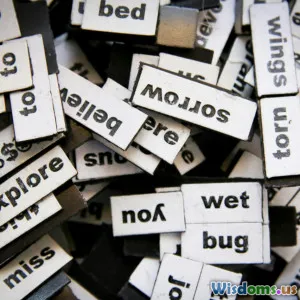
Compositional Semantics Explained With Popular Song Lyrics
13 min read Explore compositional semantics through the lens of popular song lyrics, understanding how meaning emerges from words and their combinations in everyday music. (0 Reviews)
Compositional Semantics Explained with Popular Song Lyrics
Language shapes our world, giving voice to our emotions, thoughts, and dreams. But have you ever wondered how a jumble of words becomes a lyrical masterpiece, or why certain song lines linger in our memories for decades? Welcome to the fascinating world of compositional semantics, a cornerstone of linguistics—and tonight's headline act as we decode chart-topping hits.
Music and language are partners in magic. Popular song lyrics offer a unique, playful, and deeply relatable window into the mechanisms that underpin meaning. In this article, we’ll journey from foundational concepts to memorable lines that soundtrack our lives, showing how compositional semantics transforms basic words into the unforgettable stories and feelings woven into our favorite songs.
Table of Contents
- Introduction
- What Is Compositional Semantics?
- The Magic Rule: Meaning Is Built, Not Born
- Case Study: Meaning in Song Lyric Structure
- Real-World Examples from Hit Songs
- Why It Matters: Songwriting, Listening, and Beyond
- Conclusion: Next Time You Press Play…
Introduction
It’s 7 a.m. and the radio crackles to life. A familiar tune fills the room—you hum along, only half-awake, piecing together the meaning of its lyrics. Why do some songs instantly make sense, while others keep us puzzling over their true message?
The secret is in how language works under the hood. Whether it’s Taylor Swift spinning an intricate heartbreak tale or Queen celebrating “We Are the Champions,” every lyric draws on hidden rules and logic. Compositional semantics is the science that unlocks how smaller pieces of language—words—combine to create larger meanings in phrases, sentences, and yes, our favorite choruses.
These rules work in song lyrics, ad jingles, poetry, casual chat, and epic stories alike. Understanding this process will sharpen not just your appreciation of music, but your everyday linguistic intuition.
What Is Compositional Semantics?
Let’s start with definitions.
Compositional semantics is a branch of linguistics that explores how meanings merge when we put words together. The basic belief, stemming from logician Gottlob Frege’s work (Frege Principle), is that:
"The meaning of a complex expression is determined by the meanings of its constituent expressions and the rules used to combine them."
In simple terms:
- Words: Carry individual meanings (e.g., “love,” “star”).
- Syntax (word order/rules): Dictates how we combine these meanings.
- Context: Tweaks, enhances, or entirely shifts the merged result.
Just as notes and rhythms build a melody, so do words and grammar compose semantic meaning. Pop songs, with their layered lines and catchy hooks, are the perfect playground to illustrate these ideas clearly.
Example:
- “I can’t stop the feeling!” (Justin Timberlake)
- Word meanings: “stop” (to cease), “feeling” (emotion)
- Syntax/composition: [Can’t stop] [the feeling] = Unable to halt the emotional response
This isn’t simply stacking words; it’s orchestrating meaning.
The Magic Rule: Meaning Is Built, Not Born
Imagine you have blocks labeled “love” and “hurts.” Place them side by side, and you get: “love hurts.” Simple?
But if you add “only” in front, everything changes:
- “Only love hurts.” (means nothing else does)
- “Love only hurts.” (love does nothing but cause hurt)
A small shift in how words are arranged totally alters the lyric’s message. This principle is a pillar of compositional semantics:
- Order matters
- Connectors matter (conjunctions, negation, adjectives)
- Context matters
Pop songs, with their concise and impactful lyrics, demonstrate this vividly, as catchy rhymes and rhythms are perfectly married to precise (or purposely ambiguous) meaning.
Case Study: Meaning in Song Lyric Structure
Let’s take a globally recognized line:
"You say it best when you say nothing at all." — (Ronan Keating, famously performed by Alison Krauss and Ronan Keating)
Break down the structure:
- “Say”: Express verbally
- “It best”: In the most effective way (requires contextual inference: what is said best?)
- “When you say nothing”: By remaining silent
- “At all”: Emphasizes total absence of speech
Here, particularly rich compositional mechanisms unfold:
- The syntactic arrangement signals a contrast: doing (saying) versus not doing (saying nothing)
- The overall meaning: Sometimes, silence expresses more than words ever could.
- The heartfelt punch relies on context—the listener knows the emotional circumstances through melody and delivery, enhancing literal meaning with subtext.
These tiny architectural details—what words mean, how they are ordered—construct the song’s profound emotional resonance.
Real-World Examples from Hit Songs
Pop lyrics provide an infinite sandbox for seeing compositional semantics in action. Here are four principles with real song examples.
1. Literal or Figurative?
"You are my sunshine, my only sunshine."
- Literal: Interpreted strictly, this means the person is a glowing ball of hydrogen in the sky—a physical impossibility.
- Figurative (metaphorical): Used here, “sunshine” means someone who brings joy, warmth, and light to life. The semantic system recognizes common metaphors and maps the meaning accordingly.
Compositional semantics not only builds meaning from parts but negotiates when meanings are literal or borrowed from metaphors.
"I got the eye of the tiger."
- Literal reading: The speaker has a literal tiger’s eye (biologically improbable)
- **Intended: Metaphor for focus, determination, and predatory readiness
The semantic rules work alongside shared knowledge: we infer figurative meaning because of broader musical and cultural context.
2. Ambiguity and Context
"Let it be."
- This Beatles classic is purposely ambiguous and minimalist. Every word carries multiple interpretations—“let it be” can mean acceptance, resignation, hope, or closure, depending on context and delivery.
Compositional semantics recognizes ambiguity as a feature, not a flaw. Different listeners, times, and settings might yield slightly (or vastly) different interpretations, despite identical words and syntax.
Contextual Play:
In Taylor Swift’s “Blank Space,” she sings:
“Got a long list of ex-lovers, they’ll tell you I’m insane.”
The reference to “ex-lovers” and how they’ll tell you directly implicates listeners, pulling them into a narrative perspective. Context—the persona, melody, audience expectations—animates the lyrics’ meaning further than words alone could.
3. Modifiers and Their Influence
Modifiers—adjectives, adverbs, phrases—tweak the core meaning of propositions. In pop lyrics, the right modifier can make a song immortal.
"I will always love you."
This signature line (written by Dolly Parton, famously performed by Whitney Houston) differs from “I love you” in a single word—“always.”
- “Love you” = present feeling
- “Will always love you” = unending, timeless adoration
Semantics here is constructed with the help of tense and adverbs. The permanence of feeling is baked into the meaning by word choice and order.
"Every breath you take, every move you make... I’ll be watching you."
- Here, every (quantifier) modifies the nouns to express frequency and totality.
- The cumulative meaning is obsession—a chilling twist on what could otherwise be romantic sentiment.
4. Negation and Contrast
Linguistic negation (adding “not,” “don’t,” “can’t,” etc.) upends the default state of meaning, creating new emotional and informational landscapes.
"I can’t get no satisfaction."
- Double negative: In informal English, this intensifies the message rather than reverting to a positive.
- The Rolling Stones play on prescriptive versus descriptive grammar rules—commonly understood by listeners due to song context, common usage, and melody.
"You can’t always get what you want."
- Negation (“can’t”) forms the central philosophy of the lyric—limitation, compromise.
Negation is a powerful semantic switch: one simple word changes the core proposition and, consequently, the emotional tone of the line or chorus.
Why It Matters: Songwriting, Listening, and Beyond
Understanding how compositional semantics works doesn’t just satisfy curiosity—it empowers:
- Songwriters and Lyricists: Knowing how meaning is built unlocks greater creative control. Word choice and order determine clarity, subtlety, memorability, and emotional impact.
- Listeners: Greater appreciation for what lies beneath a catchy hook makes listening more insightful and fulfilling.
- AI and NLP Technologies: Digital assistants (like Siri or Alexa) depend on compositional semantics to interpret complex requests—breaking down syntax, recognizing context, and deriving intended meaning.
Data & Research: Why Lyric Structure Matters
A 2018 study by Daniel Müllensiefen and colleagues (“The Science of Song Lyrics,” Music Perception) found that hit songs shared two clear features:
- Lyrics are comprehensible but open to interpretation, a sweet spot for linguistic creativity.
- Songs use easily parsable grammar structures—deliberate simplicity plus enough room for ambiguity, engaging both intuition and imagination.
Conclusion: Next Time You Press Play…
Maybe, after reading this, the next hit song will sound a little different. You’ll recognize the invisible scaffold: humble words, arranged by rules, made powerful by music—and yes, mined for meaning by your own, now finely tuned, compositional semantic skills.
Every lyric is a little linguistic puzzle. From the Beatles to Beyoncé, every chart-topper is a testament to our collective ability to conjure worlds from syntax, context, and melody. Whenever you sing along, you’re not just enjoying catchy tunes; you’re witnessing the greatest linguistic show on earth—compositional semantics at work.
So, pay close attention to the next lyric that makes you pause or smile. See if you can spot the hidden rules of meaning at play—and appreciate the intricate poetry hidden within popular song lyrics.
Rate the Post
User Reviews
Popular Posts

















